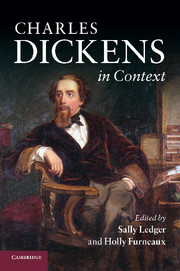Book contents
- Frontmatter
- Contents
- List of illustrations
- Notes on contributors
- Preface
- Notes on references
- PART I LIFE AND AFTERLIFE
- PART II SOCIAL AND CULTURAL CONTEXTS
- 12 Popular culture
- 13 The rise of celebrity culture
- 14 The newspaper and periodical market
- 15 Authorship and the professional writer
- 16 The theatre
- 17 Melodrama
- 18 The Bildungsroman
- 19 Visual culture
- 20 The historical novel
- 21 The illustrated novel
- 22 Christmas
- 23 Childhood
- 24 Work
- 25 Europe
- 26 The Victorians and America
- 27 Educating the Victorians
- 28 London
- 29 Politics
- 30 Political economy
- 31 The aristocracy
- 32 The middle classes
- 33 Urban migration and mobility
- 34 Financial markets and the banking system
- 35 Empires and colonies
- 36 Race
- 37 Crime
- 38 The law
- 39 Religion
- 40 Science
- 41 Transport
- 42 Illness, disease and social hygiene
- 43 Domesticity
- 44 Sexuality
- 45 Gender identities
- Further reading
- Index
21 - The illustrated novel
Published online by Cambridge University Press: 05 August 2012
- Frontmatter
- Contents
- List of illustrations
- Notes on contributors
- Preface
- Notes on references
- PART I LIFE AND AFTERLIFE
- PART II SOCIAL AND CULTURAL CONTEXTS
- 12 Popular culture
- 13 The rise of celebrity culture
- 14 The newspaper and periodical market
- 15 Authorship and the professional writer
- 16 The theatre
- 17 Melodrama
- 18 The Bildungsroman
- 19 Visual culture
- 20 The historical novel
- 21 The illustrated novel
- 22 Christmas
- 23 Childhood
- 24 Work
- 25 Europe
- 26 The Victorians and America
- 27 Educating the Victorians
- 28 London
- 29 Politics
- 30 Political economy
- 31 The aristocracy
- 32 The middle classes
- 33 Urban migration and mobility
- 34 Financial markets and the banking system
- 35 Empires and colonies
- 36 Race
- 37 Crime
- 38 The law
- 39 Religion
- 40 Science
- 41 Transport
- 42 Illness, disease and social hygiene
- 43 Domesticity
- 44 Sexuality
- 45 Gender identities
- Further reading
- Index
Summary
After Charles Dickens's death in 1870, the illustrator and painter R. W. Buss started a watercolour celebrating the author's creative imagination. Dickens's Dream (Figure 6) shows the writer sleeping in his Gad's Hill study, surrounded by his characters. Buss died before finishing the painting: Dickens's figure is fully realised and coloured, as are those of some characters, but others remain in pencil only. Even unfinished, the work conveys something fascinating about how the Victorians thought of Dickens's characters. For Buss painted Little Nell, not from his own imagination, but from George Cattermole's illustration for The Old Curiosity Shop (Figure 7); similarly, he painted Jasper and Rosa from Luke Fildes's illustration to The Mystery of Edwin Drood (Figure 8). In other words, Buss painted book illustrations. Flat, grouped in vignettes rather than realistically realised, the painting's characters are illustrations come alive. They convey the extent to which nineteenth-century readers perceived illustration as being crucial to Dickens's fiction.
Except for Hard Times and Great Expectations, all Dickens's novels were originally illustrated, principally by Hablot Knight Browne (‘Phiz’) but also by others, including George Cruikshank, Robert Seymour, George Cattermole, Samuel Williams, John Leech, Richard Doyle, John Tenniel, Daniel Maclise, Edwin Landseer, Clarkson Stanfield, Frank Stone, Marcus Stone, Charles Collins, Luke Fildes and Buss. Original readers therefore received Dickens's fiction as a combination of text and image. Dickens's works were not unique in this respect, for ‘the illustration of [Victorian] novels in their first appearance [was] widespread’.
- Type
- Chapter
- Information
- Charles Dickens in Context , pp. 166 - 177Publisher: Cambridge University PressPrint publication year: 2011



